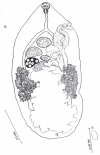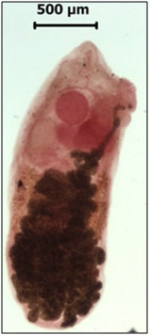NEIHPID
North-East India Helminth Parasite Information Database
Recently added
Parasites
Molecular Data
Ganeo tigrinum (Mehra et Negi Mehra et Negi)
Taxonomy
Platyhelminthes »
TREMATODA »
Digenea »
Lecithodendridae (Lühe, 1901) Odhner, 1911 »
Ganeoninae Yamaguti, 1958 »
Ganeo Klein, 1905 »
Ganeo tigrinum, Mehra et Negi 1928
Synonyms
(G. attenuatum Srivastava, 1933; G. gastricus Srivastava, 1933; G. kumaonensis Pande, 1937; G. linguanensis Li, 1938; G. srinagarensis Kaw, 1950; G. govinda Dayal et Gupta, 1953; G. punjabensis Gupta, 1954; G. bufonis Fotedar, 1959; G. lucknowensis Gupta et Jahan, 1976)
Host
Euphlyctis (cyanophlyctis), Haplobatrachus (crassus), Haplobatrachus (tigerinus), Limnonectes (sp.), Limnonectes (limnocharis), Polypedates (leucomystax), Rana (Sp.)
Habitat
Intestine
Locality
Shillong (Meghalaya), Byrnihat (Meghalaya), Khliehriat (Meghalaya), Umkiang (Meghalaya), Lumshnong (Meghalaya), Balphakram (Meghalaya), Dimapur (Nagaland), Kohima (Nagaland), Mokokchung (Nagaland)
Description
Body oval, tapering anteriorly, broadly rounded posteriorly, 2.741-3.62 mm in length, 1.21-1.496 mm in maximum width; tegumental spines present. Oral sucker round, sub-terminal. Ventral sucker spherical, located one-third of body length from anterior end. Mouth at bottom of oral sucker; pharynx globular; oesophagus of moderate length, bifurcating into two simple intestinal caeca at level of genital pore. Caeca extending up to two-thirds of body length, from anterior end beyond vitelline follicles. Testes diagonally tandem; anterior testis pre-acetabular, in median line behind intestinal bifurcation; posterior testis at level with acetabulum, partially covering right caecum. Vesicula seminalis curved antero-lateral to ventral sucker; pars prostatica large, surrounded by prostate gland cells, opening by short ejaculatory duct at base of genital atrium. Genital pore on lateral side, little anterior to level of oesophageal bifurcation. Ovary pear-shaped, postero-lateral to ventral sucker. Receptaculum seminis curved, lying behind ovary. Mehlis' gland dorso-lateral to receptaculum seminis. Vitellaria follicular, clustered along caeca, extending from posterior level of ventral sucker to some distance ahead of caecal termination. Uterus coiled transversely mainly in intercaecal zone, extending almost to posterior end of body, packed with numerous eggs; metraterm present, opening into genital atrium dorsal to ejaculatory duct. Eggs 0.023-0.028 x 0.010-0.016 mm. Excretory bladder V-shaped with median stem, excretory pore sub-terminal.
Remarks
The characters, namely, the position, size and ratio of the oral and ventral suckers, shape and size of the gonads and their relative positions to the ventral sucker, and the position and extent of vitellaria, on which most authors have based the species differentiation in the genus are found too variable to be relied upon as authentic taxonomic tools (Mukherjee, 1977). In view of the variable nature of these characters, the synonymy of several species with G. tigrinum, as proposed by Gupta(1977a,1981) is agreed to. Further, also considering the presence of vitellaria only on one side o f the body, an anomalous character (Dawes, 1946; Kaw, 1950;Mukherjee, 1977; Gupta. 1977a), the species described as having unilateral vitellaria should be considered as representing an anomalous form and not distinct species. These include G. gazipurensis Pandey and Chakraborti, 1968; G. kawi and G. vitellosinistrum Dwivedi and Chauhan, 1970; and G. ankholaensis Hafeezulla and Dutta,1985. Incidentally, the description and erection of all these as new species are based on only one or two specimens. It may be mentioned that Gupta (1977a) proposed the synonymy of G. gazipurensis to G. kumaonensis Pande, 1937, while hinting at the similarity of the latter to G. korkei Bhalerao, 1936, which is also agreed to by Rao and Kameshwari, (1976) and Ghosh and Chauhan, (1982). Several workers (Fotedar,1959; Agrawal, 1968; Mukherjee and Ghosh, 1970a;Dwivedi and Chauhan ,1970) already consider G. kumaonensis a synonym of G. tigrinum. In view of the degree of morphological variations in different structures as discussed above, it is suggested that the afore-mentioned four species with unilateral vitellaria be considered synonymous with G. tigrinum.
P. leucomystax and Rana sp. form new host records for G. tigrinum from North-East India.
Helminthological collections record
NEHU/Z - TA/1
Specimen Type
Holotype: W7757/1
References
Mukherjee, R. P. (1977) The variability of certain structures in Ganeo tigrinum, Mehra and Negi, 1928 and their taxonomic importance. Inst. Biol. Pub. Esp. pp 255-260.
Gupta, P. D. (1977a). . Studies on the genus Ganeo Klein, 1905 (Trematoda: Lecithodendriddae). Records of Zoological Survey of India. 72:pp 281-290.
Gupta, P. D. (1981) On lateral testes in the genus Ganeo Klein,1905 with remarks on synonymy of Ganeo gastricus Srivastava,1933 and Ganeo srinagarensis Kaw, 1950 with Ganeo tigrinum Mehra and Negi,1928 (Trematoda: Lecithodendriidae). Records of Zoological Survey of India. 78: pp 129-131.
Dawes, B. ( 1946). The Trematoda with special reference to British and other European forms. Cambridge Univ. Press. pp 644.
Kaw, B. L. (1950). Studies in helminthology: helminth parasites of Kashmir. Part. I. Trematoda. Indian Journal of Helminthology. 2(2):pp 67-126.
Rao, L. N. and Kameshwari, M. (1976). On the synonymy of Ganeo korkei Bhalerao, 1936 and Ganeo panjabensis Gupta, 1954 with Ganeo tigrinum Mehra and Negi,1928. Current Science. 45(17):pp 623-628.
Ghosh, R. K. and Chauhan, B.S. (1982). On a new species Ganeo behurai sp. n. (Trematoda: Lecithodendriidae) from Madras, India .Pranikee. 3:pp 1-6.
Foteder, D. N.(1959). On a new species of the genus Ganeo Klein. 1905 and some notes on the genus .Journal of Helminthology . 33:pp 151-160.
Agarwal, V. (1968) Two reptilian trematodes from Lucknow. Annals of
Mukherjee, R. P. and Ghosh, R. K. (1970a). Studies on some amphibian trematodes from Uttar Pradesh and West Bengal (Part I). Indian Journal of Helminthology. 22 (1):pp 61-78.
Dwivedi, M. P. and Chauhan, B. S. (1970). trematodes Part III. Journal of Zoological Society of India. 22:pp 165-172.




